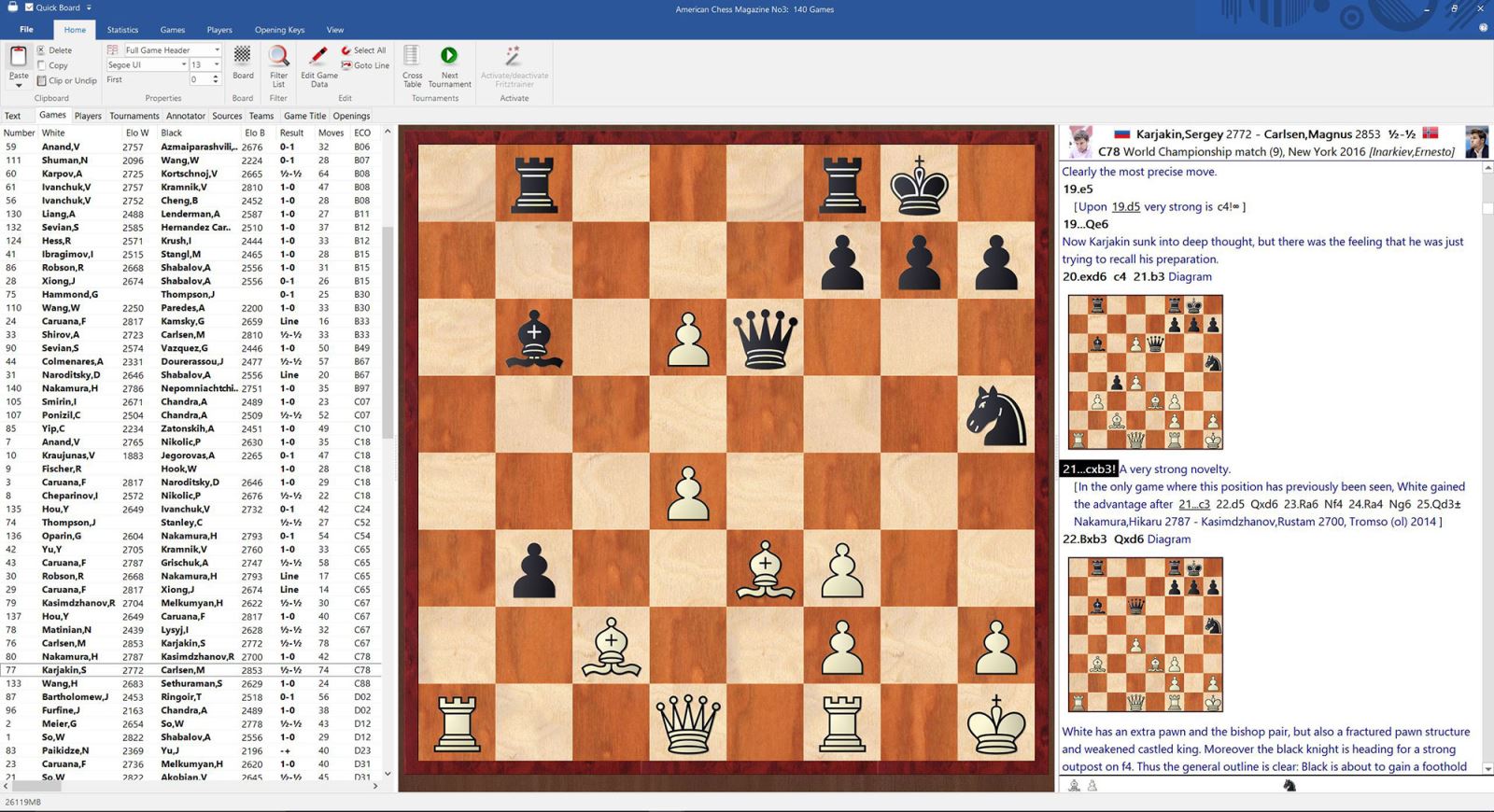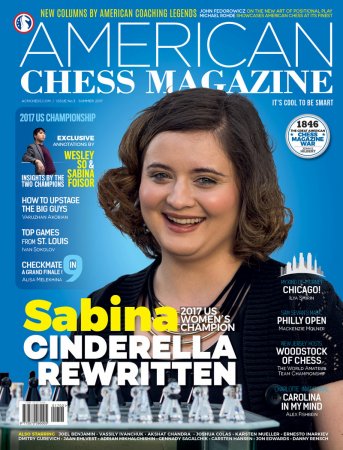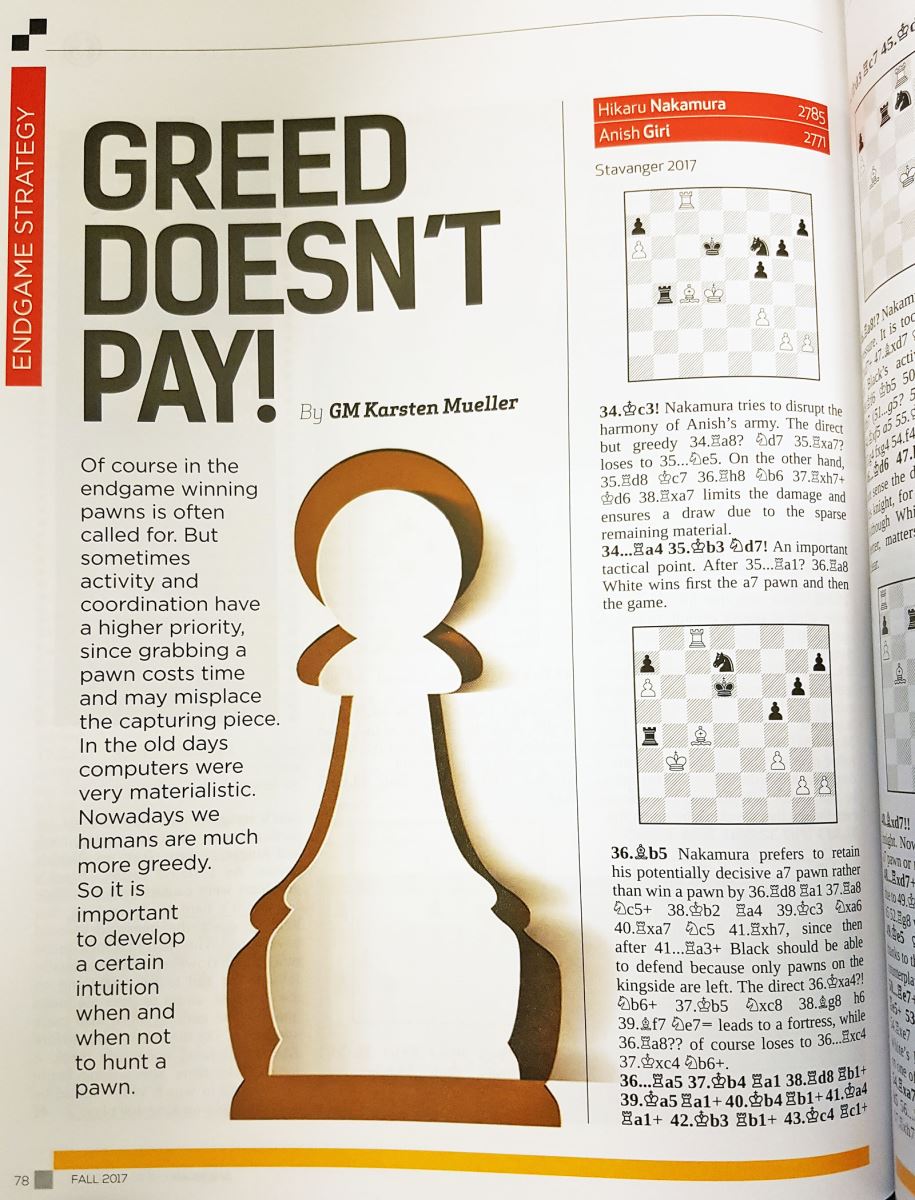


That's the title of ACM No.4, which features the menacing visage of Garry Kasparov set against a striking olive green backdrop. Bright colors have been a clear design choice, both on the cover and inside the magainze, and none of the first four glossy issues would fail to impress if you came across them on a newsstand.
Inside the content is USA-centric, but with plenty to appeal to an international audience as well, from amateur to professional.

A year in the life of the ACM | www.acmchess.com
The cover story by GM Ivan Sokolov is (not surprisingly) all about Kasparov's return to over-the-board play at the Saint Louis Rapid and Blitz. Sokolov writes:
With great anticipation the chess world awaited the return of the King. I think we can safely say that we got the playing style we expected. Dynamic, direct, and not shying away from theoretical battles!
There's a special sidebar dedicated to "Garry's Nimzo-Indian Concept of 9.h4" about which Ivan writes:
I do not know whether Kasparov fundamentally believes that White has a real advantage here or if it was a once only novelty, as was the case in no fewer than three other games played by Garry in Saint Louis, but the whole concept is new, dynamic and typical Kasparov-style chess.
In addition to Sokolov's extensive and engaging analysis, you can find more about Garry's performance in Saint Louis, in our coverage "Kasparov in St. Louis: a closer look".
Issue number four contains loads of interesting content for ChessBase readers, but naturally a few items about ChessBase also caught our eye. Firstly, there is a look at GM Simon Williams' popular DVD on The London System with 2.Bf4 — on page 104.
The London seems to be everywhere these days, from the games of World Champion Carlsen all the way down to average club players. It is a forgiving opening characterised by well-defined and easy to understand plans and structures, which will enable a player to sidestep sharp theoretical lines yet obtain a playable position with good prospects for the forthcoming middlegame.

It used to be reached by the move order 1.d4 2.Nf3 3.Bf4, but nowadays more and more people play 2.Bf4, defiantly breaking that old the rule of Tarrasch's about developing knights before bishops.
The Ginger GM, Simon Williams, is well-known for his lively online commentaries at major tournaments, which have included the opens in Gibraltar and Reykjavik this year. He has also carved out a niche for himself by his unique style of presentation in both books and DVD-ROMs, where his coverage of aggressive and offbeat openings is enhanced by his flair for drama and story-telling.
The 2.Bf4 move order adds some flexibility to White's undertaking because he doesn't necessarily have to enter the standard London with Nf3, e3, Nbd2, c3, h3 and such moves. There is then the option for the queen's knight to jump to c3 instead, such as Williams recommends against Black set-ups with …g7-g6.
On this very entertaining and quite instructive DVD-ROM Williams presents the repertoire for White. He does not get bogged down by excessive detail but concentrates on explaining typical ideas, why pieces belong on certain squares what typical tactics to look out for, etc.
ICCF Senior International Master Jon Edwards takes a deep dive into the current state of endgame tablebases, which have now reached as many as 7-pieces albeit at the almost incomprehensible size of 140 terabytes, necessitating — for now — that it can only be run on a powerful server.
Before foraying into the endgame, Edwards briefly dwells on the state of opening work, encouraging readers to "check out ChessBase's Live Book, almost certainly the largest opening database in the world."
As for the endgame, Edwards writes:
ChessBase users can install the Nalimov or Syzygy six piece Tablebases within ChessBase. Professional ChessBase installations will place these 6-piece databases in memory in order to speed processing. This kind of Tablebase integration reached its peak with the inclusion of the 3,4,5 and 6 piece results within Let's Check, ChessBase's online database of computer evaluations.
You'll find the full article on page 106.
As a free bonus, subscribers receive the chess content in ChessBase's CBV and also PGN format. That makes it easy to open any game in the issue and play through it in the interface of your choice. With full access to the issue in the form of a database, you can also home in on specific players, openings, annotators or tournaments of interest.
For instance, here are all 140 game entries in ACM 03 sorted by ECO code:

Looking at Ernesto Inarkiev's analysis of Karjakin-Carlsen, from their New York match
Click or tap to expand to full size
 So, in a sense, you get the best of both worlds: a tangible physical magazine you can flip through and stick in a briefcase or backpack, and a digital version you can play along with at home on your PC, or while on the go, on a mobile or tablet.
So, in a sense, you get the best of both worlds: a tangible physical magazine you can flip through and stick in a briefcase or backpack, and a digital version you can play along with at home on your PC, or while on the go, on a mobile or tablet.
Editor-in-Chief Josip Asik emailed us to explain that this was a deliberate strategy, and no dedicated app is currently planned.
"We noticed that among readers more are interested in a ChessBase version than any kind of digital (so we do not have a digital version at all)."
This also makes it easy for us to present a sample for you here in our feature-rich game viewer. This is the endgame column on the late legendary trainer Mark Dvoretsky from GM Karsten Mueller:
In the current issue, you'll find another Mueller column entitled "Greed Doesn't Pay!" in which Karsten writes:

Of course in the endgame winning pawns is often called for. But sometimes activity and coordination have higher priority, since grabbing a pawn costs time and may misplace the capturing piece.
In the old days computers were very materialistic. Nowadays we humans are much more greedy. So it is important to develop a certain intuition when and when not to hung a pawn.
He then starts out with a look at the endgame between Hikaru Nakamura and Anish Giri from Norway Chess 2017. "34.Kc3! Nakamura tries to disrupt the harmony of Anish's army. The direct but greedy 34.Ra8? Nd7 35.Rxa7 loses..."
See if you can spot why:
Click or tap the image above to expand and find the solution!
Karsten goes on to look at further examples from Karjakin-Caruana, as well as the Canadian Championship, World Open, and Southern California Championship (fun party trivia — California's so big they split it in two!).
A single issue costs USD $29.99, but to receive CBV & PGN files as well, you'll want to subscribe for a year (four issues) for $99, which includes free shipping for readers in the USA.
The "Letter from the Editor" column in the current issue notes with pride that ACM has won several awards from the group Chess Journalists of America, a not-for-profit organization that encourages and promotes chess journalism. Among them were a "Best Interview" award to Asik, "Best Chess Analysis" to GM Sokolov, "Best Instructive Lesson" for an article by GM Alex Fishbein, and — perhaps most noteworthy — "Best Magazine / Newsletter Layout".
A flip through any of the first four issues, and it's not hard to see why.